Small overlap front: driver-side
Rating applies to 2019-22 models
Tested vehicle: 2019 Hyundai Veloster 2.0 Premium 3-door
The Hyundai Veloster was redesigned for the 2019 model year after a one-year absence from the market. The sporty hatchback features an unusual door configuration, with the passenger side having two conventionally hinged doors and the driver side only a single door.
| Evaluation criteria | Rating |
|---|---|
| Structure and safety cage | |
| Driver injury measures | |
| Head/neck | |
| Chest | |
| Hip/thigh | |
| Lower leg/foot | |
| Driver restraints and dummy kinematics | |
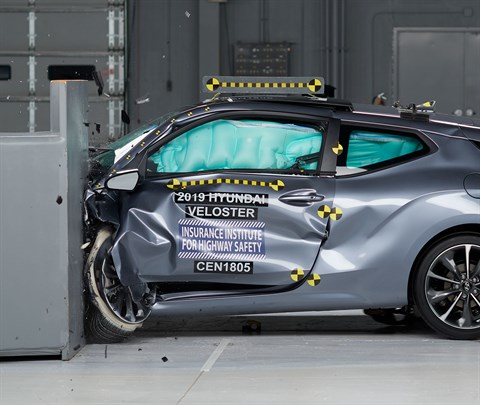
Action shot taken during the driver-side small overlap frontal crash test.
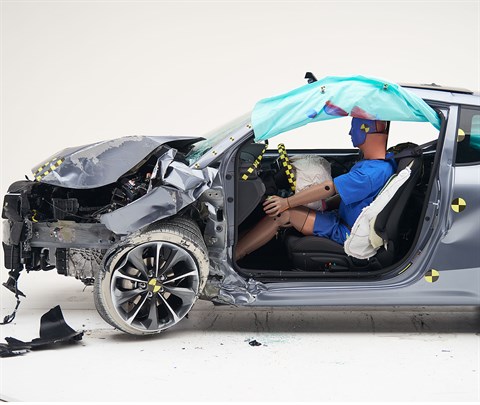
The dummy's position in relation to the door frame, steering wheel, and instrument panel after the crash test indicates that the driver's survival space was maintained very well.
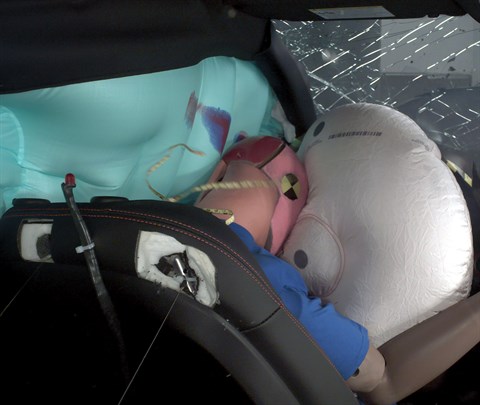
The frontal and side curtain airbags worked well together to keep the head from coming close to any stiff structure or outside objects that could cause injury.
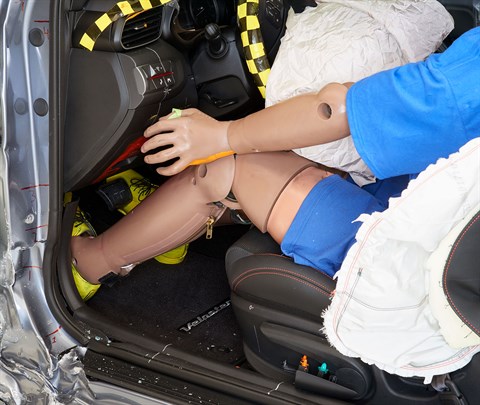
The driver's space was maintained well, and risk of injuries to the dummy's legs and feet was low.
Measures of occupant compartment intrusion on driver side
| Evaluation criteria | Measurement |
|---|---|
| Test ID | CEN1805 |
| Lower occupant compartment | |
| Lower hinge pillar max (cm) | 7 |
| Footrest (cm) | 4 |
| Left toepan (cm) | 3 |
| Brake pedal (cm) | 4 |
| Parking brake (cm) | |
| Rocker panel lateral average (cm) | 1 |
| Upper occupant compartment | |
| Steering column | 1 |
| Upper hinge pillar max (cm) | 3 |
| Upper dash (cm) | 4 |
| Lower instrument panel (cm) | 4 |
Driver injury measures
| Evaluation criteria | Measurement |
|---|---|
| Test ID | CEN1805 |
| Head | |
| HIC-15 | 173 |
| Peak gs at hard contact | no contact |
| Neck | |
| Tension (kN) | 1.0 |
| Extension bending moment (Nm) | 10 |
| Maximum Nij | 0.21 |
| Chest maximum compression (mm) | 23 |
| Femur (kN) | |
| Left | 0.6 |
| Right | 0.2 |
| Knee displacement (mm) | |
| Left | 0 |
| Right | 0 |
| Knee-thigh-hip injury risk (%) | |
| Left | 0 |
| Right | 0 |
| Maximum tibia index | |
| Left | 0.42 |
| Right | 0.62 |
| Tibia axial force (kN) | |
| Left | 3.1 |
| Right | 0.5 |
| Foot acceleration (g) | |
| Left | 74 |
| Right | 35 |
Small overlap front: passenger-side
Rating applies to 2019-22 models
Tested vehicle: 2019 Hyundai Veloster 2.0 Premium 3-door
The Hyundai Veloster was redesigned for the 2019 model year after a one-year absence from the market. The sporty hatchback features an unusual door configuration, with the passenger side having two conventionally hinged doors and the driver side only a single door.
Passenger-side small overlap frontal ratings are assigned by the Institute based on a test conducted by Hyundai.
| Evaluation criteria | Rating |
|---|---|
| Overall evaluation | |
| Structure and safety cage | |
| Passenger injury measures | |
| Head/neck | |
| Chest | |
| Hip/thigh | |
| Lower leg/foot | |
| Passenger restraints and dummy kinematics | |
| Driver injury measures | |
| Head/neck | |
| Chest | |
| Hip/thigh | |
| Lower leg/foot | |
| Driver restraints and dummy kinematics | |
Measures of occupant compartment intrusion on passenger side
| Evaluation criteria | Measurement |
|---|---|
| Test ID | VTP1909 |
| Lower occupant compartment | |
| Lower hinge pillar max (cm) | 7 |
| Footrest (cm) | 7 |
| Right toepan (cm) | 6 |
| Center toepan (cm) | 2 |
| Rocker panel lateral average (cm) | 3 |
| Upper occupant compartment | |
| Center dash (cm) | 3 |
| Upper hinge pillar max (cm) | 3 |
| Upper dash (cm) | 4 |
| Right lower dash (cm) | 5 |
Passenger injury measures
| Evaluation criteria | Measurement |
|---|---|
| Test ID | VTP1909 |
| Head | |
| HIC-15 | 138 |
| Peak gs at hard contact | no contact |
| Neck | |
| Tension (kN) | 0.8 |
| Extension bending moment (Nm) | 6 |
| Maximum Nij | 0.14 |
| Chest maximum compression (mm) | 22 |
| Femur (kN) | |
| Left | 0.6 |
| Right | 0.1 |
| Knee displacement (mm) | |
| Left | 0 |
| Right | 0 |
| Knee-thigh-hip injury risk (%) | |
| Left | 0 |
| Right | 0 |
| Maximum tibia index | |
| Left | 0.46 |
| Right | 0.42 |
| Tibia axial force (kN) | |
| Left | 2.5 |
| Right | 3.1 |
| Foot acceleration (g) | |
| Left | 49 |
| Right | 57 |
Driver injury measures
| Evaluation criteria | Measurement |
|---|---|
| Test ID | VTP1909 |
| Head | |
| HIC-15 | 99 |
| Peak gs at hard contact | no contact |
| Neck | |
| Tension (kN) | 1.4 |
| Extension bending moment (Nm) | 19 |
| Maximum Nij | 0.35 |
| Chest maximum compression (mm) | 30 |
| Femur (kN) | |
| Left | 0.2 |
| Right | 0.2 |
| Knee displacement (mm) | |
| Left | 1 |
| Right | 0 |
| Knee-thigh-hip injury risk (%) | |
| Left | 0 |
| Right | 0 |
| Maximum tibia index | |
| Left | 0.37 |
| Right | 0.18 |
| Tibia axial force (kN) | |
| Left | 0.4 |
| Right | 0.7 |
| Foot acceleration (g) | |
| Left | 36 |
| Right | 51 |
Moderate overlap front: original test
Rating applies to 2019-22 models
Tested vehicle: 2019 Hyundai Veloster 2.0 Premium 3-door
The Hyundai Veloster was redesigned for the 2019 model year after a one-year absence from the market. The sporty hatchback features an unusual door configuration, with the passenger side having two conventionally hinged doors and the driver side only a single door.
Moderate overlap frontal ratings are assigned by the Institute based on a test conducted by Hyundai.
| Evaluation criteria | Rating |
|---|---|
| Overall evaluation | |
| Structure and safety cage | |
| Driver injury measures | |
| Head/neck | |
| Chest | |
| Leg/foot, left | |
| Leg/foot, right | |
| Driver restraints and dummy kinematics | |
Measures of occupant compartment intrusion on driver side
| Evaluation criteria | Measurement |
|---|---|
| Test ID | VTF1816 |
| Footwell intrusion | |
| Footrest (cm) | 1 |
| Left (cm) | 8 |
| Center (cm) | 2 |
| Right (cm) | 1 |
| Brake pedal (cm) | 3 |
| Instrument panel rearward movement | |
| Left (cm) | 0 |
| Right (cm) | 0 |
| Steering column movement | |
| Upward (cm) | -1 |
| Rearward (cm) | -4 |
| A-pillar rearward movement (cm) | 0 |
Driver injury measures
| Evaluation criteria | Measurement |
|---|---|
| Test ID | VTF1816 |
| Head | |
| HIC-15 | 181 |
| Peak gs at hard contact | no contact |
| Neck | |
| Tension (kN) | 1.1 |
| Extension bending moment (Nm) | 22 |
| Maximum Nij | 0.22 |
| Chest maximum compression (mm) | 26 |
| Legs | |
| Femur force - left (kN) | 1.4 |
| Femur force - right (kN) | 1.5 |
| Knee displacement - left (mm) | 1 |
| Knee displacement - right (mm) | 0 |
| Maximum tibia index - left | 0.75 |
| Maximum tibia index - right | 0.63 |
| Tibia axial force - left (kN) | 1.5 |
| Tibia axial force - right (kN) | 1.9 |
| Foot acceleration (g) | |
| Left | 94 |
| Right | 103 |
Side: original test
Rating applies to 2019-22 models
Tested vehicle: 2019 Hyundai Veloster Turbo Ultimate 3-door
The Hyundai Veloster was redesigned for the 2019 model year after a one-year absence from the market. The sporty hatchback features an unusual door configuration, with the passenger side having two conventionally hinged doors and the driver side only a single door.
Two tests of the Veloster were conducted, the first by the Institute and the second by Hyundai. During the first test, the driver door opened. This opening didn't significantly affect vehicle crush or dummy movement but shouldn't happen because, in some crashes, it could allow partial or complete occupant ejection, especially if the occupant is unbelted.
The door opening led Hyundai to modify the cars to prevent this occurrence beginning with 2019 models built after January 2019, and Hyundai has implemented a recall to apply the same fix to cars built earlier. (Information about when a specific vehicle was manufactured is on the certification label typically affixed to the car on the driver door or adjacent B-pillar.)
In the second test conducted by Hyundai on a car with the modifications, the driver door did not open. Ratings of the Veloster are based on the results of both tests.
| Evaluation criteria | Rating |
|---|---|
| Overall evaluation | |
| Structure and safety cage | |
| Driver injury measures | |
| Head/neck | |
| Torso | |
| Pelvis/leg | |
| Driver head protection | |
| Rear passenger injury measures | |
| Head/neck | |
| Torso | |
| Pelvis/leg | |
| Rear passenger head protection | |
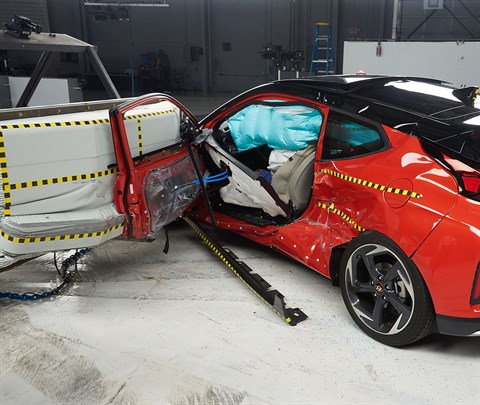
View of the vehicle and barrier just after the Institute's crash test. The driver door opened, but the dummy's movement during the crash wasn't significantly affected.
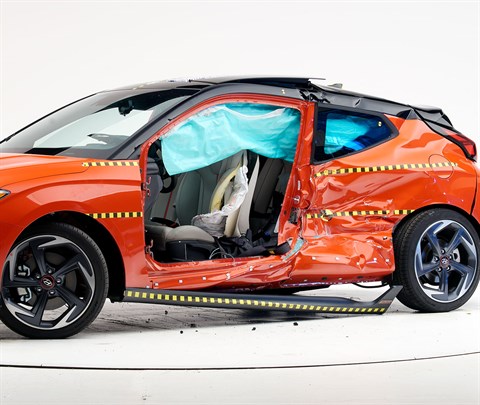
View of the vehicle after the crash with door removed, showing the side airbags and damage to the occupant compartment (Institute test car shown).
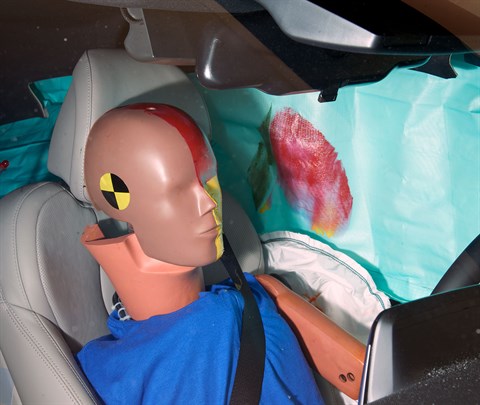
Smeared greasepaint shows where the driver dummy's head was protected from being hit by hard structures by the side curtain airbag in the Institute's test.
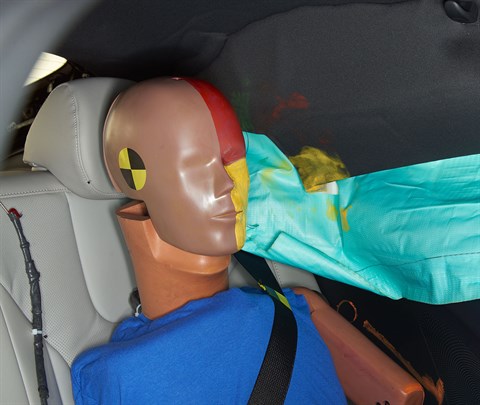
Smeared greasepaint shows where the rear passenger dummy’s head was protected by the side airbag.
Measures of occupant compartment intrusion on driver side
| Test ID | CES1805 | VTS1909 |
|---|---|---|
| B-pillar to longitudinal centerline of driver's seat (cm) | -15.5 | -17.5 |
| Negative numbers indicate the amount by which the crush stopped short of the seat centerline. | ||
Driver injury measures
| Evaluation criteria | Measurement | |
|---|---|---|
| Test ID | CES1805 | VTS1909 |
| Head HIC-15 | 295 | 369 |
| Neck | ||
| Tension (kN) | 1.1 | 1.4 |
| Compression (kN) | 0.5 | 0.4 |
| Shoulder | ||
| Lateral deflection (mm) | 30 | 28 |
| Lateral force (kN) | 1.7 | 1.8 |
| Torso | ||
| Maximum deflection (mm) | 33 | 36 |
| Average deflection (mm) | 30 | 33 |
| Maximum deflection rate (m/s) | 6.94 | 5.86 |
| Maximum viscous criterion (m/s) | 0.54 | 0.79 |
| Pelvis | ||
| Iliac force (kN) | 2.2 | 1.9 |
| Acetabulum force (kN) | 1.4 | 1.6 |
| Combined force (kN) | 3.7 | 3.4 |
| Left femur | ||
| L-M force (kN) | 0.7 | 0.5 |
| L-M moment (Nm) | 94 | 123 |
| A-P moment (Nm) | 35 | -25 |
Passenger injury measures
| Evaluation criteria | Measurement | |
|---|---|---|
| Test ID | CES1805 | VTS1909 |
| Head HIC-15 | 153 | 289 |
| Neck | ||
| Tension (kN) | 0.2 | 0.8 |
| Compression (kN) | 0.7 | 0.2 |
| Shoulder | ||
| Lateral deflection (mm) | 39 | 44 |
| Lateral force (kN) | 1.5 | 1.8 |
| Torso | ||
| Maximum deflection (mm) | 29 | 31 |
| Average deflection (mm) | 21 | 19 |
| Maximum deflection rate (m/s) | 2.56 | 2.88 |
| Maximum viscous criterion (m/s) | 0.36 | 0.43 |
| Pelvis | ||
| Iliac force (kN) | 0.1 | 0.1 |
| Acetabulum force (kN) | 0.7 | 0.4 |
| Combined force (kN) | 0.7 | 0.4 |
| Left femur | ||
| L-M force (kN) | 1.3 | 1.1 |
| L-M moment (Nm) | 204 | 201 |
| A-P moment (Nm) | -74 | 56 |
Roof strength
Rating applies to 2019-22 models
Tested vehicle: 2019 Hyundai Veloster 2.0 3-door
| Overall evaluation | |
|---|---|
| Curb weight | 2,709 lbs |
| Peak force | 14,248 lbs |
| Strength-to-weight ratio | 5.26 |
Head restraints & seats
Seat type: Manual cloth seat
| Overall evaluation | |
|---|---|
| Dynamic rating | |
| Seat/head restraint geometry |
| Seat type | Manual cloth seat |
|---|---|
| Geometry | |
| Backset (mm) | 34 |
| Distance below top of head (mm) | -3 |
| Seat design parameters | |
| Pass/fail | Pass |
| Max T1 acceleration (g) | 10.4 |
| Head contact time (ms) | 67 |
| Force rating | 1 |
| Neck forces | |
| Max neck shear force (N) | 57 |
| Max neck tension (N) | 527 |
About the head restraint & seat test
Currently, IIHS tests apply only to front seats.
Headlights
Ratings are given for 2 different headlight variations available on this vehicle.
Trim level(s)
- Turbo R-Spec trim
- Turbo trim
- Turbo Ultimate trim
| Evaluation criteria | Rating |
|---|---|
| Low-beam headlight type | LED projector |
| High-beam headlight type | Halogen reflector |
| Curve-adaptive? | No |
| High-beam assist? | Yes |
|
Overall rating | |
| Distance at which headlights provide at least 5 lux illumination: | |
Low beams
On the straightaway, visibility was good on both sides of the road. On curves, visibility was good in all 4 tests.
The low beams created some glare.
High beams
On the straightaway, visibility was good on the right side of the road and inadequate on the left side. On curves, visibility was good on the gradual left and gradual right curves and fair on the sharp left and sharp right curves.
High-beam assist compensates for some limitations of this vehicle's low beams on the sharp right curve.
| Evaluation criteria | Measurement |
|---|---|
| Trim level(s) |
|
| Low-beam headlight type | LED projector |
| High-beam headlight type | Halogen reflector |
| Curve-adaptive? | No |
| High-beam assist? | Yes |
|
Overall rating Applies to 2019-22 models |
| LOW BEAMS | Average minimum useful illumination distance (5 lux) |
Amount glare exceeded threshold |
|---|---|---|
| Straightaway right edge | 107.4 m | 11.1% |
| Straightaway left edge | 67.5 m | 11.1% |
| 250m radius right curve, right edge | 81.9 m | None |
| 250m radius left curve, left edge | 84.7 m | 23.0% |
| 150m radius right curve, right edge | 59.9 m | None |
| 150m radius left curve, left edge | 61.7 m | None |
| HIGH BEAMS | Average minimum useful illumination distance (5 lux) |
|---|---|
| Straightaway right edge | 159.5 m |
| Straightaway left edge | 78.3 m |
| 250m radius right curve, right edge | 85.6 m |
| 250m radius left curve, left edge | 86.7 m |
| 150m radius right curve, right edge | 62.6 m |
| 150m radius left curve, left edge | 63.4 m |
Trim level(s)
- 2.0 trim
- 2.0 Premium trim
| Evaluation criteria | Rating |
|---|---|
| Low-beam headlight type | Halogen projector |
| High-beam headlight type | Halogen reflector |
| Curve-adaptive? | No |
| High-beam assist? | No |
|
Overall rating | |
| Distance at which headlights provide at least 5 lux illumination: | |
Low beams
On the straightaway, visibility was fair on the right side of the road and inadequate on the left side. On curves, visibility was inadequate in all 4 tests.
The low beams never exceeded glare limits.
High beams
On the straightaway, visibility was good on the right side of the road and inadequate on the left side. On curves, visibility was inadequate in all 4 tests.
| Evaluation criteria | Measurement |
|---|---|
| Trim level(s) |
|
| Low-beam headlight type | Halogen projector |
| High-beam headlight type | Halogen reflector |
| Curve-adaptive? | No |
| High-beam assist? | No |
|
Overall rating Applies to 2019-21 models |
| LOW BEAMS | Average minimum useful illumination distance (5 lux) |
Amount glare exceeded threshold |
|---|---|---|
| Straightaway right edge | 78.6 m | None |
| Straightaway left edge | 34.7 m | None |
| 250m radius right curve, right edge | 42.9 m | None |
| 250m radius left curve, left edge | 36.2 m | None |
| 150m radius right curve, right edge | 36.5 m | None |
| 150m radius left curve, left edge | 33.6 m | None |
| HIGH BEAMS | Average minimum useful illumination distance (5 lux) |
|---|---|
| Straightaway right edge | 148.0 m |
| Straightaway left edge | 95.7 m |
| 250m radius right curve, right edge | 57.8 m |
| 250m radius left curve, left edge | 55.2 m |
| 150m radius right curve, right edge | 46.1 m |
| 150m radius left curve, left edge | 44.6 m |
Front crash prevention: vehicle-to-vehicle
Ratings are given for 2 different trim variations available on this vehicle.
Front crash prevention: pedestrian (day)
Child seat anchors
Rating applies to 2019-22 models
| Evaluation criteria | Rating |
|---|---|
| Overall evaluation | |
| Vehicle trim | Turbo Ultimate |
| Seat type | leather |
This vehicle has 2 rear seating positions with complete child seat attachment (LATCH) hardware.
| Evaluation criteria | Rating |
|---|---|
| Overall evaluation | |
| Vehicle trim | Turbo Ultimate |
| Seat type | leather |
| Rating icon | Rating |
|---|---|
| G | Good |
| A | Acceptable |
| M | Marginal |
| P | Poor |
| Seating positions that rely on borrowed lower anchors or have only a tether anchor available are not rated. | |
thether anchor symbol | Tether anchor |
lower anchor symbol | Lower anchors |
| Lower anchor(s) can be borrowed from adjacent positions(s) | |
| No hardware available |
Details by seating position
| Position | Rating |
|---|---|
| 1 | |
| Tether anchor | |
| hard-to-find location | |
| no other hardware could be confused for anchor | |
| Lower anchors | |
| too deep in seat | |
| not too much force needed to attach | |
| easy to maneuver around anchors | |
| 3 | |
| Tether anchor | |
| hard-to-find location | |
| no other hardware could be confused for anchor | |
| Lower anchors | |
| too deep in seat | |
| not too much force needed to attach | |
| easy to maneuver around anchors |
Seat position 21
| Lower anchor A | |
|---|---|
| Open access rated | No |
| Depth (cm) | 2-4 |
| Force (lbs) | 19 |
| Clearance angle (degrees) | 69 |
| Lower anchor B | |
| Open access rated | No |
| Depth (cm) | 2-4 |
| Force (lbs) | 24 |
| Clearance angle (degrees) | 80 |
| Tether anchor | |
| Location | Floor |
| Confusing hardware present | No |
| Has contrasting label within 3 inches of tether anchor |
Yes |
| Tether anchors can be accessed while seatback is properly positioned for use of LATCH |
Not measured |
Seat position 23
| Lower anchor A | |
|---|---|
| Open access rated | No |
| Depth (cm) | 2-4 |
| Force (lbs) | 31 |
| Clearance angle (degrees) | 78 |
| Lower anchor B | |
| Open access rated | No |
| Depth (cm) | 2-4 |
| Force (lbs) | 30 |
| Clearance angle (degrees) | 59 |
| Tether anchor | |
| Location | Floor |
| Confusing hardware present | No |
| Has contrasting label within 3 inches of tether anchor |
Yes |
| Tether anchors can be accessed while seatback is properly positioned for use of LATCH |
Not measured |
